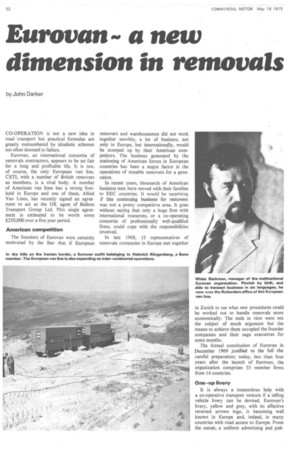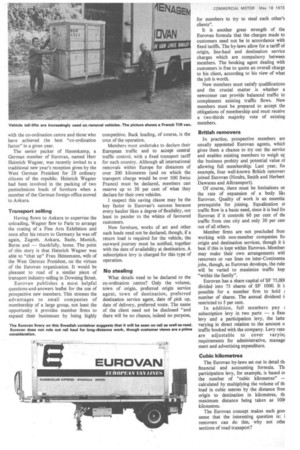Eurovan pay a new dimension in removals
Page 54

Page 55

Page 56

If you've noticed an error in this article please click here to report it so we can fix it.
by John Darker CO-OPERATION is not a new idea in road transport but practical formulae are greatly outnumbered by idealistic schemes too often doomed to failure.
Eurovan, an international consortia of removals contractors, appears to be set fair for a long and profitable life. It is not, of course, the only European van line. CETI, with a number of British removers as members, is a rival body. A number of American van lines has a strong foothold in Europe and one of these, Allied Van Lines, has recently signed an agreement to act as the UK agent of Bullens Transport Group Ltd. This single agreement is estimated to be worth some £250,000 over a five-year period.
American competition The founders of Eurovan were certainly motivated by the fear that if European removers and warehousemen did not work together sensibly, a lot of business, not only in Europe, but internationally, would be scooped up by their American competitors. The business generated by the stationing of American forces in European countries has been a major factor in the operations of sizeable removers for a generation.
In recent years, thousands of American business men have moved with their families to EEC countries. It would be surprising if this continuing business for removers was not a pretty competitive area. It goes without saying that only a huge firm with international resources, or a co-operating consortia of professionally well-qualified firms, could cope with the responsibilities involved.
In late 1968, 15 representatives of removals companies in Europe met together in Zurich to see what new procedures could be worked out to handle removals more economically. The ends in view were not the subject of much argument but the means to achieve them occupied the founder companies and their sage executives for some months.
The formal constitution of Eurovan in December 1969 justified to the full the careful preparation; today, less than four years after the launch of Eurovan, the organization. comprises 55 member firms from 14 countries.
One-up livery
It is always a tremendous help with a co-operative transport venture if a telling vehicle livery can be devised. Eurovan's livery, yellow and grey, with its effective reversed arrows logo, is becoming well known in Europe and, indeed, in many countries with road access to Europe. From the outset, a uniform advertising and pub licity programme supported the common vehicle livery.
Much more difficult — but rewarding — was the development of a common tariff and the agreement of member companies to Use a standard form of contract and standdard conditions of carriage. The latter had been hammered out by the United Nations Economic Commission for Europe and were, in some respects, more onerous than the normal conditions of carriage of the British Association of Removers. The "paper work" (documentation) used by Eurovan companies is of uniform design and this helps the staffs of the member companies to feel they are part of the whole enterprise.
In effect, a package deal was created. If the separate conditions of carriage, insurance and contractual arrangements of a number of countries applied to an international furniture removal, endless complications could follow if a disgruntled customer had recourse to law. With Eurovan, whether a customer moves from Paris to Rome, or from Frankfurt to Madrid, the same conditions apply from home of arigin to final destination.
The customer is a major beneficiary of ;uch an internationally agreed contractual Irrangement, and member companies — f they face higher overheads — at least ;et the advantage of a standard ;ystem. In this age of consumerism t makes little sense, in my view, for cornnercial contracts to be based on the lowest xammon denominator of service and legal lability. Far better seize the nettle of high bindards. The member companies of Eurovan together control trucks, pantechnicons, semi-trailers, etc, equivalent to some 700 TIR units, About 15 per cent of the vehicles have been painted in the company colours and this proportion will grow as work expands to keep the fleet fully extended on purely international operations.
Road v. rail neutrality
Eurovan is closely involved with containerization developments and is, I understand, neutral as between road and rail. The competitive situation is, of course, fluid: more onerous drivers' hours legislation may tilt the scales in favour of rail, at least for the longer distances. Mr Michael Scott, chairman and managing director of Pitt and Scott Ltd, a British member of Eurovan and secretary of the Eurovan company, says a number of members use a new type of German container of about 1300 Cu ft capacity. This "box" is roughly 23ft 6in. long but is fitted with standard ISO twistlocks at 20ft pitch, so is movable on platform skeletal trailers.
Ideally, of course, Eurovan companies would standardize on a limited range of vehicles but any moves in this direction will be slow because of the complexities of loading, transporting, unloading, setting up and warehousing.
Although founded as an intra-European co-ordination body it is logical and appropriate that Eurovan should extend the intercontinental operations of its members. This business is growing — Eurovan members handled over 80,000 cubic metres of intercontinental household removals in 1971, a figure excluding military and commercial traffic.
Multilingual treasure
The co-ordination of the European and inter-continental activities of Eurovan led to the setting up of a central office at Rotterdam in 1972. The manager at Rotterdam, Mr Widar Backman, was formerly manager of the removals department of Oy Victor Ek, in Helsinki. He was president of the Finnish International Removal Association on its foundation in 1968 and vice-president of the surface traffic section of FIDI — the international association of removers. Add to these professional interests a remarkable facility in languages — fluent Swedish, Finnish, German and English and passable French, Danish and Norwegian — and you see why Eurovan's 33-year-old Rotterdam manager is a treasure!
Shared traffic information is the essence of co-operation for mutual benefit in road transport. Eurovan's traffic co-ordinator, Mrs Ingrid Strasser, keeps tabs on all Eurovan movements to ensure load co-ordination and maximum utilization of vehicles for return loads.
The Eurovan organization makes awards annually for member firms showing the greatest volume of traffic passing through the network and for members showing the greatest traffic increase over the previous year. It is an excellent idea to recognize, too, the member firms who have liaised best with the co-ordination centre and those who have achieved the best "co-ordination factor" in a given year.
The senior packer of Hasenkamp, a German member of Eurovan, named Herr Heinrich Wagner, was recently invited to a traditional new year's reception given by the West German President for 28 ordinary citizens of the republic. Heinrich Wagner had been involved in the packing of two pantechnicon loads of furniture when a member of the German foreign office moved to Ankara.
Transport selling Having flown to Ankara to supervise the unloading, Wagner flew to Paris to arrange the crating of a Fine Arts Exhibition and soon after his return to Germany he was off again, Zagreb, Ankara, Basle, Munich, Berne and — thankfully, home. The point of this story is that Heinrich Wagner was able to "chat up" Frau Heinemann, wife of the West German President, on the virtues of the Eurovan organization. It would be pleasant to read of a similar piece of transport industry-selling in Downing Street.
Eurovan publishes a most helpful questions-and-answers leaflet for the use of prospective new members. This stresses the advantages to small companies of membership of a large group, not least the opportunity it provides member firms to expand their businesses by being highly competitive. Back loading, of course, is the crux of the operation.
Members must undertake to declare their European traffic and to accept central traffic control, with a fixed transport tariff for each country. Although all international removals within Europe for distances of over 200 kilometres (and on which the transport charge would be over 500 Swiss Francs) must be declared, members can reserve up to 30 per cent of what they declare for their own vehicles.
I suspect this saving clause may be the key factor in Eurovan's success because every haulier likes a degree of flexibility, not least to pander to the whims of favoured customers.
New furniture, works of art and other such loads need not be declared, though, if a return load is required for the vehicle, the outward journey must be notified, together with the date of availability at destination. A subscription levy is charged for this type of operation.
No stealing
What details need to be declared to the co-ordination centre? Only the volume, town of origin, preferred origin service agent, town of destination, preferred destination service agents date of pick up, date of delivery, preferred route. The name of the client need not be disclosed "and there will be no chance, indeed no purpose,
for members to try to steal each other's clients".
It is another great strength of the Eurovan formula that the charges made to customers need not be in accordance with fixed tariffs. The by-laws allow for a tariff of origin, line-haul and destination service charges which are compulsory between members. The booking agent dealing with customers is free to quote an overall charge to his client, according to his view of what the job is worth.
New members must satisfy qualifications and the crucial matter is whether a newcomer can provide balanced traffic to complement existing traffic flows. New members must be prepared to accept the obligations of membership and must receive a two-thirds majority vote of existing members.
British removers In practice, prospective members are usually appointed Eurovan agents, which gives them a chance to try out the service and enables existing members to weigh ur the business probity and potential value ol allowing full membership. Last year, fen example, four well-known British removers joined Eurovan (Honks, Smith and Herbert Dawsons and Alltransport).
Of course, there must be limitations or, the rate of expansion of a body like Eurovan. Quality of work is an essentia prerequisite for joining. Equalization oi traffic flow is a basic need, since it is bad fo; Eurovan if it controls 60 per cent of the traffic from one city and only 30 per cm out of all others.
Member firms are not precluded fronr working with non-member companies fo] origin and destination services, though it i; best if this is kept within Eurovan. Member; may make their own arrangements wid removers or van lines on inter-Continenta jobs, though, as Eurovan develops, the rule; will be varied to maximize traffic kep "within the family".
Eurovan has a share capital of SF 75,00( divided into 75 shares of SF 1000. It possible for a member firm to hold ; number of shares. The annual dividend i restricted to 5 per cent.
In addition, full members pay ; subscription levy in two parts — a fixee levy and a participation levy, the latte varying in direct relation to the amount o traffic booked with the company. Levy rate are adjustable to cover varyinl requirements for administrative, manage ment and advertising expenditure.
Cubic kilometres The Eurovan by-laws set out in detail tit financial and accounting formula. Th participation levy, for example, is based o; the number of "cubic kilometres" — calculated by multiplying the volume of th load in cubic metres by the distance fron origin to destination in kilometres, th maximum distance being taken as 1004 kilometres.
The Eurovan concept makes such g000 sense that the interesting question is: i removers can do this, why not othe sections of road transport?
















































































































